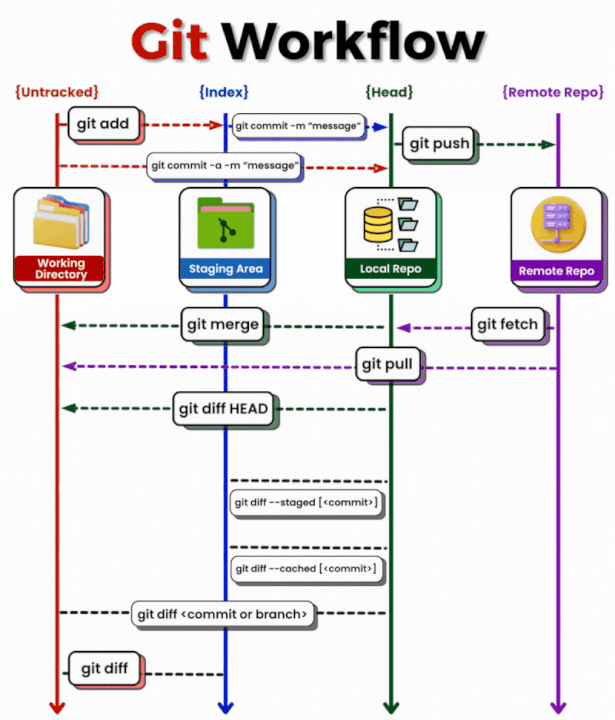- Vishakha Sadhwani
- Posts
- Git for DevOps
Git for DevOps
What every Cloud & DevOps engineer should really know about Git
Hi Inner Circle,
If you’ve been in the DevOps world for more than a few weeks, you’ve probably already used Git.
But here’s the catch — most engineers treat Git as just a version control tool, not the critical DevOps trigger it truly is.
In reality, Git powers much more than code history.
It’s what enables you to:
Manage and version infrastructure as code
Roll back broken deployments and detect drifts
Trace what changed, when, and by whom
Collaborate seamlessly across teams without stepping on each other’s toes
Also, ever heard of GitOps? Yeah — entire deployment models now revolve around Git as the single source of truth.
In this edition, we’re breaking down Git for DevOps — what to actually focus on, how to practice it right, and the most common interview scenarios you’ll run into.
Let’s get started.

Why Git Matters in DevOps Workflows
Git isn’t just about tracking code. In modern DevOps, it’s tightly woven into:
CI/CD Pipelines → Triggers builds, runs tests, deploys apps.
Infrastructure as Code → Tracks changes in Terraform, Helm, Kubernetes YAMLs.
Incident Recovery → Rollbacks depend on reliable version history.
Audit & Compliance → Git logs = change history and root cause analysis.
GitOps Workflows → Git becomes the single source of truth — changes pushed to Git automatically sync with the cluster via controllers like ArgoCD or Flux.
This makes Git not just a developer tool — but a must-know for DevOps engineers.
Quick Note: Git ≠ GitHub
Let’s clear this up — Git is a distributed version control system. It works entirely on your local machine and helps you track changes, branch safely, and manage history.
GitHub, on the other hand, is a platform built on top of Git. It adds cloud hosting, collaboration, PR reviews, GitHub Actions, and integrations.
You can use Git without GitHub. You can also use alternatives like GitLab or Bitbucket. But the core Git fundamentals — branching, commits, merges — stay the same across all.
Git Skills That Actually Matter in DevOps
Here’s a roadmap of Git concepts — from basics to workflows you’ll actually use in production.
1. Git Basics (Don’t skip)
git init,git clone,git statusgit add,git commit,git diffgit log,git show
✱ Why it matters: Without these, you’ll struggle to debug or understand a repo’s history.
2. Branching & Merging
git checkout -b,git merge,git branch -dUnderstanding fast-forward vs recursive merges
✱ Why it matters: You’ll often need to patch hotfixes, isolate environments, or roll forward with zero conflicts.
3. Remote Collaboration
git remote,git fetch,git pull,git pushDealing with conflicts in shared repos
✱ Why it matters: Most DevOps workflows involve collaborating on infrastructure or pipeline code across teams.
4. Git History Debugging
git blame,git bisect,git reflogReverting changes:
git resetvsgit revert
✱ Why it matters: Imagine a prod outage caused by a misconfigured Terraform variable — and you need to find who changed what and when. This is how.
5. Advanced Workflows
Rebase:
git rebase,git rebase -iStashing:
git stash,git stash popHooks: Pre-commit and pre-push hooks for enforcing standards
✱ Why it matters: Clean PRs, zero-downtime deploys, and automated checks all rely on deeper Git workflow understanding.
4 Very Common Real-World Scenario Questions
Here are some real examples of how Git comes up in interviews and day-to-day DevOps roles:
1. A CI pipeline failed after merging a PR — how would you debug it?
What they’re testing: Your ability to trace recent code changes and pinpoint the root cause.
Sample approach:
Check the commit history with
git logUse
git show <commit>to view what changedIf needed, use
git bisectto isolate the breaking commit (not everyones knows about this)Revert with
git revertif needed, and patch safely
2. Two team members pushed changes to the same file — how do you resolve the conflict?
What they’re testing: Collaboration and merge conflict resolution.
Sample approach:
Pull the latest changes:
git pullResolve conflicts manually by editing the file
Mark resolved files:
git add <file>Finalize with
git commit
3. You accidentally deleted a branch — can you recover it?
What they’re testing: Comfort with Git internals and recovery commands. Because there’s a possibility that this can happen:)
Sample approach:
Use
git reflogto find the deleted branch's last commitRestore it with:
git checkout -b <branch> <commit-hash>
4. You’ve been working on a feature branch while main has moved ahead — now your PR shows unrelated commits.
What they’re testing: Whether you can sync your branch cleanly using rebase instead of a merge.
Sample Approach:
git fetch origin
git rebase origin/main
This replays your commits on top of the latest main — keeping history linear and clean.
Where to Start: Resources & Practice Repos
If you’re new to Git — or want to move beyond the basics — here’s a curated set of practical resources:
Tutorials
Pro Git Book (by Git SCM) - if You LIKE Reading
Hands-On Practice
Git in DevOps Context
Final Thoughts
Git is more than version control. That’s it.
So when you're learning Git:
Don’t stop at
git commit— learn what happens under the hoodDon’t just memorize — build mental models through scenarios
Don’t avoid merge conflicts — resolve them by understanding why it happened first.
Next Thursday — we’re diving into Python for DevOps and the required automation, integration, and debugging Skills for Cloud Engineers
Also 👇️
Start learning AI in 2025
Keeping up with AI is hard – we get it!
That’s why over 1M professionals read Superhuman AI to stay ahead.
Get daily AI news, tools, and tutorials
Learn new AI skills you can use at work in 3 mins a day
Become 10X more productive